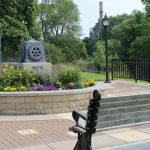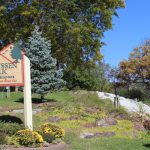City focuses on riverfront
By Angie Landsverk
Facade improvements, ecological preservation, habitat restoration and trail improvements are among the highest priorities in Waupaca’s new Riverfront Park Master Plan.
This update to the Rotary Riverview Park Plan includes Washington Park, Rasmussen Park and Schwenn/Lions (Hidden) Park.
“It’s a culmination of about eight months of work,” said Brennan Kane, Waupaca’s director of community and economic development.
A year ago, the common council approved a $75,020 budget to update Rotary Riverview Park’s plan.
During the city’s downtown master planning process, this area was identified as one in need of additional study, he said.
In April 2017, RDG Planning & Design unveiled the proposed redesign of Main Street.
The city hired the Des Moines, Iowa firm in early 2016 for the Main Street reconstruction and redevelopment plan.
The infrastructure under the street is more than 100 years old.
Reconstruction of Main Street, from Badger to Water streets, is scheduled for 2021.
The plan the firm presented last year identified the Waupaca River as an underused asset.
As a result, city staff recommended updating Rotary Riverview Park’s plan, and including other parks in the downtown area as well.
The city wants to improve the community’s connection to the river running through its downtown.
Rotary Riverview Park is located along the Waupaca River on Cooper Street, behind Main Street.
“I heard people travel about 45 minutes to come to Waupaca and fish,” Ryan Peterson said. “It is an asset you should not overlook.”
Peterson is a landscape architect at RDG Planning & Design.
He presented Waupaca’s Riverfront Park Master plan to the common council on May 15.
The council adopted the plan that evening.
“There’s a lot of opportunity here, and we see great potential here,” Peterson said.
The master plan recognizes a community the size of Waupaca cannot do everything within it all at once, he said.
Peterson described it as a 20 to 25-year vision for Waupaca and said the city will not be responsible for more than 50 percent of the cost of any of the projects in it.
Grants and private partnerships will be sought.
Themes, goals
Rotary Riverview Park anchors the back side of Main Street, Peterson said.
“We’re looking for ways to get more people down there and leverage the space for what it can be,” he said.
Last August, RDG met with Steering Committee members to identify ways to improve Rotary Riverview Park, Rasmussen Park and Hidden Park.
These themes emerged:
• Connect the riverfront.
• Integrate the arts through partnerships.
• Aesthetics matter.
• Visibility is key.
• The river is the backbone.
• Promote economic development.
The goals build on those themes and include to:
• Spur economic development downtown.
• Create a park that is an attraction for both downtown and the community.
• Improve the habitat and the stream corridor.
• Connect Waupaca citizens to the natural environment.
The process included looking at what is happening to the Waupaca River by mapping its course over time, while also looking at the floodway.
Property owners in this area pay additional flood insurance.
The city’s consultants also studied vehicular and pedestrian circulation, as well as views and sight lines.
Plan’s focus
The master plan focuses on three areas and seeks to offer opportunities for people of all ages, backgrounds and abilities.
The areas are “The Wilds,” Main Street’s backyard and the connective region.
The Wilds is a wooded area by Rasmussen Park.
Preserving this area could turn it into an outdoor classroom for the community and a place to hike and spend a lunch hour, Peterson said.
Improvements proposed for this area include enhancing the urban prairie, managing the woodlands, paving the Challenge Trail, connecting to current trails and expanding Rasmussen Park’s garden.
Rotary Riverview Park is downtown’s backyard.
Improvement opportunities in this area include speed bumps to increase pedestrian safety, an events lawn, a wade-in area, streambank restoration, a new shelter with restrooms, a riverwalk/boardwalk and a canoe/kayak launch.
The connective region is the area south and east of the Main street backyard.
It includes the footbridge that has been closed for a number of years and Hidden Park.
The improvements proposed for this area include a veteran’s memorial plaza, a community garden/plaza, improved play elements, a loop walk, some clearing to open views to the river and improved sight lines so people are able to see Hidden Park from across the river.
Peterson said the public wants a footbridge, and options remain on the table.
The best use of Hidden Park was a topic during the planning process.
Needs there include more security, an ecological preservation strategy and for the neighborhood to take ownership of the park, he said.
Top priorities
Identified as high priority projects for the next five years were:
• A Facade and Site Improvement Program to clean up the back sides of the buildings. A foundation or funding source to go toward such a program would need to be developed.
• Waupaca River flood protection. This includes looking at the floodplain, doing a flood protection study and seeing if there is an opportunity for a delineation of the floodplain.
• Washington/Rasmussen Park. Proposed for this area are ecological preservation and trail improvements.
• Creating a trail to Swan Park.
• A new park shelter (with restrooms) in Rotary Riverview Park, and lawn improvements as well.
• Habitat restoration and park cleanup.
“I think it fits in with what Waupaca is trying to strive toward,” Peterson said of the master plan.


